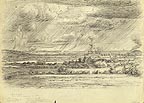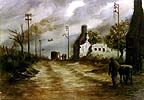Soon after the Allied invasion troops fought their way off the landing beaches, they encountered the communities of those they had come to liberate. Although the price in devastation was high as the fighting swirled through their streets, the liberating result to the inhabitants was much preferable to the continued presence of their Nazi occupiers.
British Positions Behind Beach Early Morning
Mitchell Jamieson #V37
Charcoal & wash, June, 1944
88-193-RN
 Unidentified
Landscape
Unidentified
Landscape
Mitchell Jamieson #V-62
Pen & Charcoal, circa 1944
88-193-SO
color notes on the bottom
 Usurper's
Watchtower
Usurper's
Watchtower
Dwight C. Shepler #153
Watercolor, June 1944
88-199-FA
The lovely 15th century spire at Colleville-Sur-Mer Normandy dominated a view of the Omaha beachhead, and was a well-wired observation post for Nazi gunfire. On confirmation of this fact, the destroyer U.S.S. Emmons was called upon to knock the tower down with some highly accurate shooting at noon of D-Day. To those who sailed that ship the tall spire will ever be a melancholy ghost.
 Old
Campaigners (Cold and Wet)
Old
Campaigners (Cold and Wet)
Mitchell Jamieson #230a
Watercolor, June 1944
88-193-IG
These are men of the U.S. Navy's 6th Beach Battalion in the Omaha sector. The terrible, confused experience of the landing and the first two days on the beach had by now turned into a routine pattern of hard work, sleeplessness and the kind of living conditions generally described as "rugged." The men already had the look of old campaigners, each adapting himself in his own way to his surroundings. Beach battalion losses were heavy here. They hit the shore with the first waves, but in this sector where resistance was so fierce, the work of organizing the unloading was virtually impossible until it was secured to some degree. The sign in the background pointed to one of the exits from the beach, which was just to the right of the picture. The men live in foxholes between here and the water's edge.
 Old
Campaigners (Preliminary Sketch)
Old
Campaigners (Preliminary Sketch)
Mitchell Jamieson #230b
Charcoal & wash, June 1944
88-193-IH
 Near
a Mine Field in Verville-Sur-Mer
Near
a Mine Field in Verville-Sur-Mer
Alexander P. Russo #23
Ink with wash, June 10, 1944
88-198-W
These troops had been ashore for four days and were in the town of Verville-Sur-Mer, about one and a half miles inland from Omaha Beach. What was once a pleasant country town became a mass of ruin and devastation. It had the flavor and stench of death to these weary Yanks. Mine fields were a German defensive obstacle designed to "channel" advancing Allied troops into destructive fields of artillery and machinegun fire.
 This
Road Leads To a Beach Called Omaha
This
Road Leads To a Beach Called Omaha
Alexander P. Russo #25
Watercolor, 1944
88-198-Y
Normandy, June10, 1944. On this street in Verville-Sur-Mer, peasant life went on as usual after the terrific shelling on D-Day. Occasional shells from the enemy lines dropped close by, but life went on as usual. A tarpaulin covered a dead German to the left of the road. Tethered Allied barrage balloons, visible in the distance, were designed to protect the Allied beachhead from low-flying German aircraft.
 Street
in Verville-Sur-Mer
Street
in Verville-Sur-Mer
Alexander P. Russo #31
Gouache, 1944
88-198-AE
An American MP directed an armored car through a transit area, June 10,1944. Military policemen were vital in directing Allied vehicular traffic and "keeping them rolling" toward the front. The destructive effect of the war on the local inhabitants and their property is evident.
1 2 3 4 5 6 7 8 9 10 11 12 13 14 15 16 17 18 19 20 21 22 23 24 25